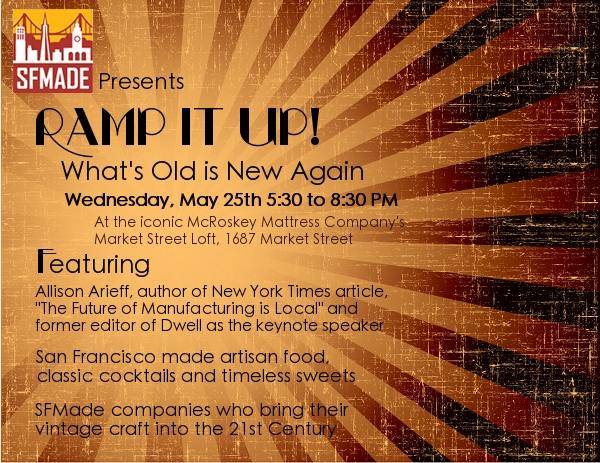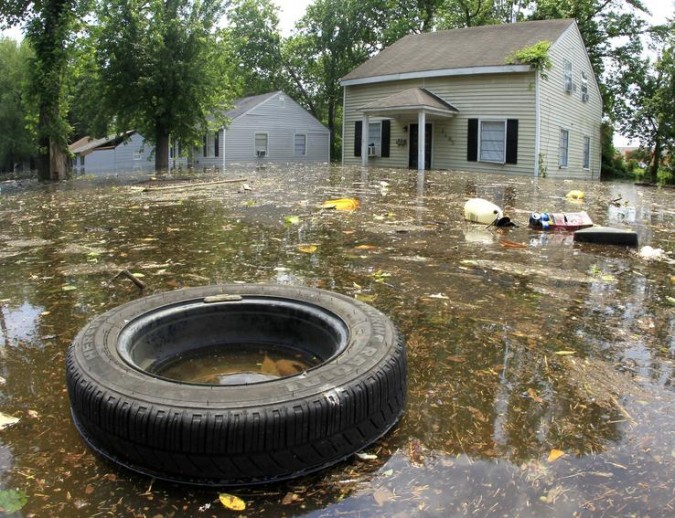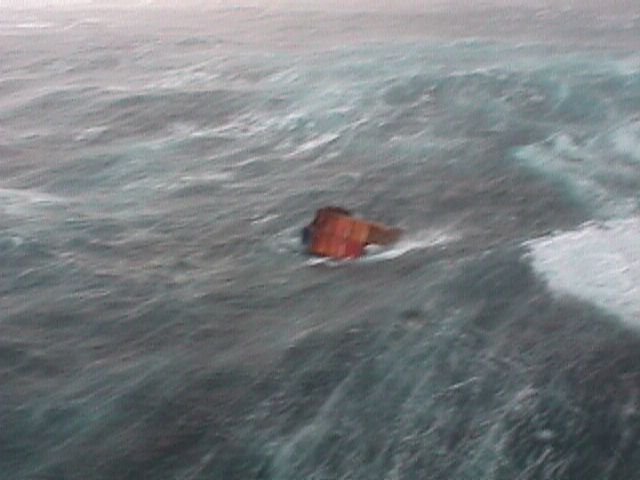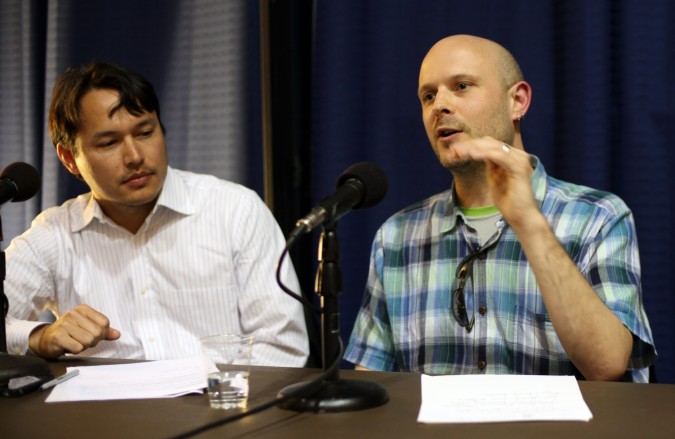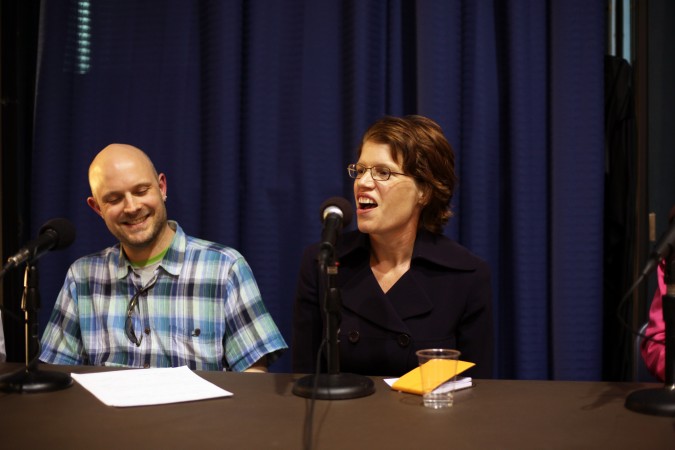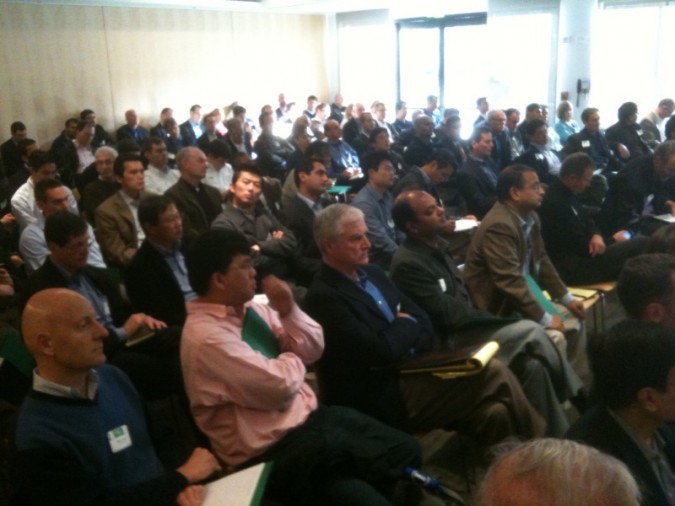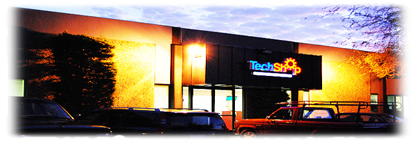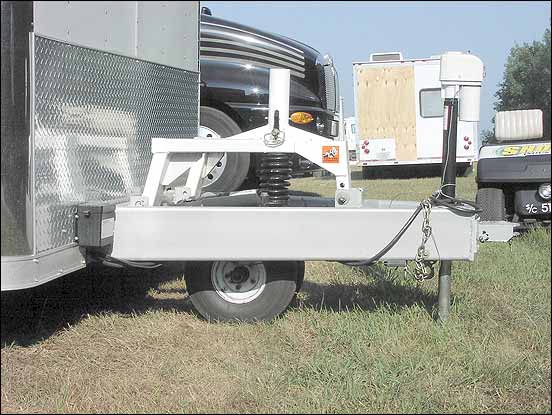Archive for the ‘green homes’ tag
I’m attending Ramp It Up, a fundraiser by SFMade.org
I’m considering manufacturing self contained green homes in San Francisco, California. I don’t know much about the manufacturing business, and I have few contacts in the industry. To help fix that, I’m going to the first SFMade annual fund raiser tonight.
SFMade is a new trade organization that formed to promote the interests of companies that manufacture physical goods in San Francisco.
I first wrote about SFMade on Feburary 28, 2011.
Here’s the link to the event page for this SFMade event, titled Ramp It Up.
The ticket price is USD $45.00, of which USD $25.00 is tax deductible under US tax laws.
Flood resistant homes built from ocean shipping containers
The more I dream about becoming a builder of green homes, the more ideas I come up with.
Today’s crazy idea was inspired by the dramatic 2011 Mississippi River floods now happening.
As I’ve disclosed here before, I want to base my green homes, at least to start, on recycled ocean shipping containers. These containers are strong, waterproof and standardized across the planet. Many companies and private individuals already make homes from shipping containers. I have many spins on the concepts that I think make my plans stand out from other plans I’ve seen.
Unaltered containers are pretty water tight. They are so water tight that when they fall off a container ship during a storm, they float for a while — even months is possible. They are a major hazard for other boats and ships, because they are very hard to spot, as they float so that most of the container is submerged, with only about a foot sticking up out of the water. If a boat hits a floating container, that boat can sink from the damage caused by the impact.
My uncle Gerald Warnock is an avid fisherman. On our most recent fishing expedition, last month, I was telling him about my green housing ideas, and he said floating containers are such a marine hazard that there are plans being discussed to install a ‘fuse’ in the side of containers that will disintegrate when immersed in water. Thus, an overboard container will flood and sink once the fuse disintegrates. This will send the cargo to the bottom, but make water travel safer.
I think it would be better to put a satellite beacon in every container, and have the beacon activate when the container is imersed in water. Then the container location could be broadcast on the Internet, and treasure seekers could go pick up the container. Perhaps there could be a bounty sharing treaty set up so the entity salvaging the container would get to keep half of the value and the original owner would get the other half.
People on land spend hours with metal detectors looking for valuables on beaches and elsewhere. I bet that overnight a mini industry would spring up if there were an electronic map overlay website with dots where floating lost shipping containers potentially filled with valuable new products could be found. In fact, I predict that salvagers would compete and the team with the fastest ship would prevail. I don’t know how ships get public data at sea, but there must be a way to publish container location GPS coordinates via a low cost system that can be accessed while at sea. Since the containers are on the move, one would need up to the minute satellite beacon information to justify spending fuel money to travel to a location where a container is supposed to be. I advocate publishing the contents and declared value of the container’s contents along with the coordinates, so salvagers will be able to gauge whether it’s worth it to make the trip. Environmental groups should like my plan, as sunken containers probably aren’t a good thing.
That’s not my idea I intended to write up in this post… it’s just another one of my ideas I’ve wanted to write up for a while now.
My idea I intended to write in this post is to use the shipping container door as the home door, leaving the weather stripping intact. Yes, I would dress up the door and insulate it, to increase its asthetic appeal. But if I leave the original door, then the home can stay watertight if I make the other openings similarly watertight.
Thus, the windows would have to have shutters that could be closed, and the shutters would need to be water tight like the door. The roof hatch also would need to be water tight, and any openings for plumbing lines, electrical lines and the like also would need to be watertight.
Such watertight products already exist for the maritime industry. The roof hatch on a sailboat is reasonably watertight, and while these cost more than a house skylight, they’re not that much more costly. I doubt a sailboat hatch could withstand water pressure if the container were many feet underwater. So, to combat that threat, I could use a submarine hatch! That should handle whatever pressure develops… Seriously though, I doubt flooded areas encounter flood depths such that marine grade trap doors and hatches would not keep most or all of the water out.
The resident of a green home built as I describe here could weather a flood by just closing the door, the windows and the roof hatch. Even if the home were entirely underwater, it would remain dry inside. I wouldn’t recommend trying to live inside, as the air would run out in short order, of course. But when news of an impending flood is received, it would take just minutes to close up the house and depart for higher ground.
There will be tremendous societal benefit to avoiding the billions of dollars in flood damage that results from our current non-waterproof housing.
Shipping container homes without waterproof doors, windows and roof hatches are already very resistant to earthquakes and tornados. Adding waterproofing is not really much extra work, and I would consider making it standard for all homes in flood prone areas, and an available option for all homes, since flooding is likely to get worse over the next few centuries, and I predict any green homes I make from shipping containers will endure for at least a century. These would not be throwaway mobile homes with a cheap feel from day one. These would be rock solid, nearly indestructible homes to pass down from generation to generation.
When I was touring NIMBY a while back to look for space to build a container home, I saw shipping containers from decades ago, from before their design was standardized by the ISO. These things don’t fall apart. I think a properly designed container home clad in suitable exterior siding like brick or granite could last indefinitely — certainly as long as the centuries old housing one sees in parts of Amsterdam and Paris.
Social Capital: The Intersection of Money and Meaning – at Commonwealth Club of California
Last evening I attended a talk entitled Social Capital: The Intersection of Money and Meaning at The Commonwealth Club of California.
The speakers were:
Patrick Donohue — co-founder and CEO of The Hoop Fund
David Hodgson — Co-founder of Connective
Kate Sofis — Executive Director of SF Made
Penelope Douglas — President of the Board of SOCAP
I got to meet Kate Sofis, the Executive Director of SF Made. You may recall that I wrote about SF Made in February, 2011 and in that post wrote that I hoped to meet Sofis. I didn’t at the time know that I would meet her just over a month later.
Sofis reminded me about Modern Cabana, a company I originally learned about from my friend Kevin Casey of New Avenue, Inc. Sofis told the audience that Modern Cabana consists of just 2 people, the co-founders. This was one of the most inspiring facts I’ve learned since joining the Commonwealth Club less than 6 months ago.
Modern Cabana offers an appealing product from an attractive website. The company appears to be much bigger than it is. They are based in San Francisco, and make their products in San Francisco, according to Sofis. This is just outstanding news for me, since I am thinking about making a business of selling off-grid capable green homes, and I would like to do this in San Francisco, since I don’t plan to move and I don’t want to commute to a different city to work, as I think commuting long distances to work is itself unhealthy, unwise and not green.
Here’s a clip from the talk. The first speaker shown is Penelope Douglas. The second speaker is Kate Sofis of SF Made. I had nice conversations with all of the panelists after the formal program concluded.
Of course, the panel talked about much more than Modern Cabanas. The primary point I believe the speakers were making is that good can be done by investing in and creating double bottom line businesses. This subject is close to my heart, thanks to the education provided to me by my friends Priya Haji and Siddharth Sanghvi.
2011 Cleantech Opportunities and Outlook: The Investors’ Perspective
The law firm Orrick LLP puts on an outstanding free event series it calls Total Access. The events are organized by Chad Lynch, Orrick’s Director of Corporate Business Development. I met Chad around six years ago when I was working really hard on my startup gOffice.com, then the world’s only true online office suite. I haven’t seen Chad in years, but I reintroduced myself today, and he remembered meeting me and remembered the year. He knows thousands of people I’m certain, so he sure has a good memory for faces.
Chad Lynch used to have the comparable job at the law firm Pillsbury Wintrop, an Orrick competitor. That’s when I met him. I’ve stayed in touch via his emails, and today I went to my first Total Access event in years. They begin at 7:15am in Menlo Park, California, and I live in San Francisco, so I have to wake up really early to get down there on time, particularly since the direct route is Highway 101, which is particularly congested during rush hour compared to the other major North/South route, Interstate 280.
I’m glad I braved the traffic this morning, as the event was worth my while. The subect matter was ‘Cleantech Opportunities and Outlook: The Investors’ Perspective.’ There was a panel of four venture capitalists, including one I know from my days raising venture capital for my first Internet startup Hotpaper.com, which I later sold at a profit to Purple Communications (then GoAmerica, Inc. – NASDAQ GOAM).
The panel answered about three dozen questions over an hour. The consensus is that Cleantech is now past its baby steps, but still a toddler. The group was upbeat about the prospects for starting and funding cleantech companies in 2011. Interestingly, the panel did not see any new solar panel companies getting funded unless the panel efficiency is to be over 20% and the cost per watt is to be under a dollar! These requirements represent a very high bar, from the little I know about that industry. I sure wouldn’t want to be trying to get a solar panel company funded today.
What made the event so worthwhile is I gave my elevator pitch for the ‘green homes’ idea I’m kicking around in my head as a possible venture to work on. The VC panelist I know actually seemed interested and asked me to email him an executive summary. I wasn’t even planning on telling him about green homes, but he saw my new green homes business card and asked me about it, even though there was a line of people twenty minutes deep waiting to shake his hand. We had a nice chat about it, and he was familiar with California AB1866, the law that gives ‘green homes’ potential legs to stand on.
As soon as I finished talking with this VC, a cleantech attorney pitched his boutique cleantech law firm to me, and said he had experience with land use issues I would be sure to encounter. While I’m very loyal to Eric Jensen, my corporate attorney since the mid 1990s, I might schedule a lunch with this guy to hear what he has to say, since I don’t think Eric knows much about land use issues and real estate in general. Eric’s an amazing attorney though, and for high tech ventures it’s unlikely you could do better. I’ve known Eric since 1989 when he was a brand new associate at Cooley LLP. Now he heads their business department.
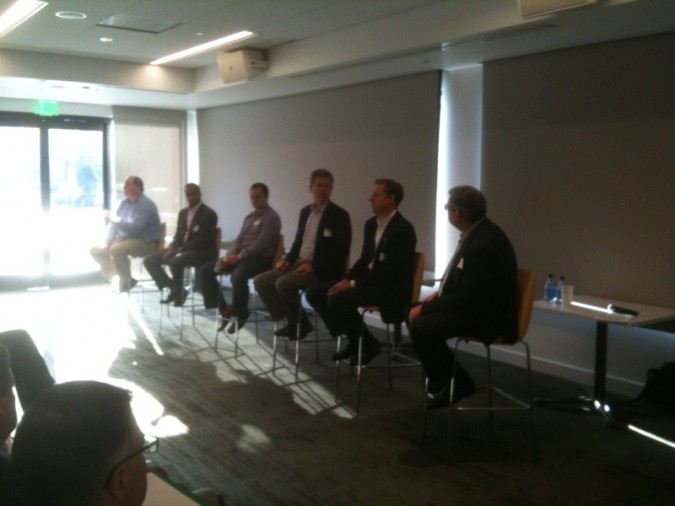
Orrick Cleantech Panel Dec 16, 2010 Menlo Park, California. Left to right: Erik Strasser, Ravi Viswanathan, Warren Hogarth, Don Wood, Jeffrey Adams, Mitch Zuklie
As you can see from the above Apple iPhone 3GS photos (sorry for the low quality) I took at the event, there is a lot of interest in Cleantech. There were people standing in the aisle to my left out of camera view. Remember, this was early in the morning, so I found the turnout to be amazing. Chad told the audience that Orrick has signed up 90 new clients from these events, which, again, are free to attend, and all you need is an invitation which you can get by signing up online at Orrick’s website.
The panelists were from well known and well respected firms. Erik Strasser is General Partner at Mohr Davidaw Ventures. Ravi Viswanathan is General Partner at New Enterprise Associates. Warren Hogarth is Partner at Sequoia Capital. Don Wood is Managing Director at Draper Fisher Jurvetson. Jeffrey Adams is Managing Director at Goldman Sachs. The moderator was Mitch Zuklie, Partner at Orrick LLP. I introduced myself to all the panelists except Mitch, who ducked out before I had a chance to say hello.
Note that while Orrick is staging these events to market themselves, they soft pedal that aspect, and I think only about 60 seconds of the event was spent on asking for business.
The subject matter covered by these events is broad, and it’s certainly much broader than cleantech. I recommend Total Access events without reservation.
TechShop in Menlo Park, California
I am writing this post from TechShop in Menlo Park, California. TechShop is a membership do it yourself shop. They have a wide array of tools so costly and large one could not own them and keep them at home, unless one had a really large house and was prepared to devote most of it to a workshop.
I am really excited right now, as TechShop will soon open a branch location in San Francisco, just a block from the Moscone Center convention center. This location is easy to get to from my house as the Muni Metro stops at Montgomery Street, just a few blocks from the new TechShop.
I joined TechShop today as a full member of the as yet unopened San Francisco branch. One of the perks is that one can use the Menlo Park shop free of charge until the San Francisco branch opens, which could happen any week now. It’s supposed to open this month, but apparently the more realistic opening time is next month.
I got a thorough and exhaustive tour of the Menlo Park TechShop from a very enthusiastic employee named Mel. I told him about my desire to one day build extremely green homes from ocean shipping containers, and he got it immediately. He advised getting started as soon as possible as he said the media will love this idea, and there is an upcoming TV show to be shot at TechShop next year that would probably like to cover a project like this provided it’s beyond the idea phase.
I’ve been thinking about Green Homes, my code name for the project, particularly feverishly this month. Many of the intriguing ideas I’ve worked up in my head for my bus conversion apply to shipping container based green housing as well. I really want to help make the world a better place, and I’ve become a huge fan of the movement away from so-called McMansions towards more realistic sized homes.
I’ve struggled with how I would promote such a business and make sales. I have decided that among the best ways to spread the word would be to make a prototype home and take it on tour, the way Jay Shafer of Tumbleweed Houses does with his small conventionally constructed houses. Shipping containers are heavy, so I can’t tow one with my car. But, thankfully, I have a bus conversion that can tow a large trailer. I checked today and it appears there are hitch mounting points in place, as I saw connection points to let the vehicle be towed from the back. These anchor points are massive.
A shipping container home will be heavy, as a 20 foot container empty weighs nearly 5,000 pounds. By the time I add granite counters and tile floors the weight could be up around 10,000 pounds. Even for a bus conversion this is heavy, but there’s a cool product that I read about first just last evening. It’s called Tuff Tow. Tuff Tow is a pair of wheels you install into the trailer up front by the hitch. These wheels are freeway capable, and are on a swivel mount. These wheels can support up to 2,000 pounds. The idea is that the large majority of the tongue weight of the trailer is offloaded onto the Tuff Tow device, and only a few hundred pounds is placed on the actual vehicle hitch. This means my bus conversion would only have to deal with pulling the container, and not with potentially huge vertical axis forces, which would be especially high going over bumps and dips in the road at speed. The Tuff Tow costs $1,700 but it will make towing a heavy green home painless for the tow vehicle, and it will mean I can detach the home from the tow vehicle without jacks, I believe.
I can envision myself driving around North America showing a self contained green home, giving speeches, participating in panel discussions, educating politicians, inspiring students and generally being an advocate for more efficient living. I think I would be a good television guest, and that I could direct my sales skills towards persuading people to change their aspirations for an ever larger home. While a bus conversion might seem to be a counter productive tow vehicle due its huge size, my conversion gets 11 miles per gallon as it’s a 4 cylinder, not an 6 or 8 cylinder like most bus conversions. A bus is long and heavy, which makes for safer towing of a heavy trailer. But the real benefit to using the conversion is that I can avoid the heavy footprint and cost of staying in a hotel while on tour, as I can stay up front in the conversion. If I tried to stay in hotels with a shipping container home hitched to a 15 mpg pickup truck, I don’t know where I would park the combo, as I doubt many hotels would want me to take up five parking places to rent one room. The bus conversion is also a great demonstration of small and efficient living, so visitors would be able to see two compact homes at once, which I think increases the public relations value of any tour.
While I don’t yet know if it’s possible, my current plan is to weld trailer axles directly to the shipping containers, fabricate the A shaped hitch, install a Tuff Tow unit up front and tow the container without attaching it to a trailer, as the container would itself be a very durable self contained trailer. I’ve not seen such a trailer before, so this might well be one of the key early inventions of mine in my quest to become a green home entrepreneurial leader.
From what I’ve seen and picked up from the several hours I’ve now been at TechShop, I am hopeful that by my membership here that I will be able to make quick progress towards making my first green home, using many of the amazing tools and resources they have here.
